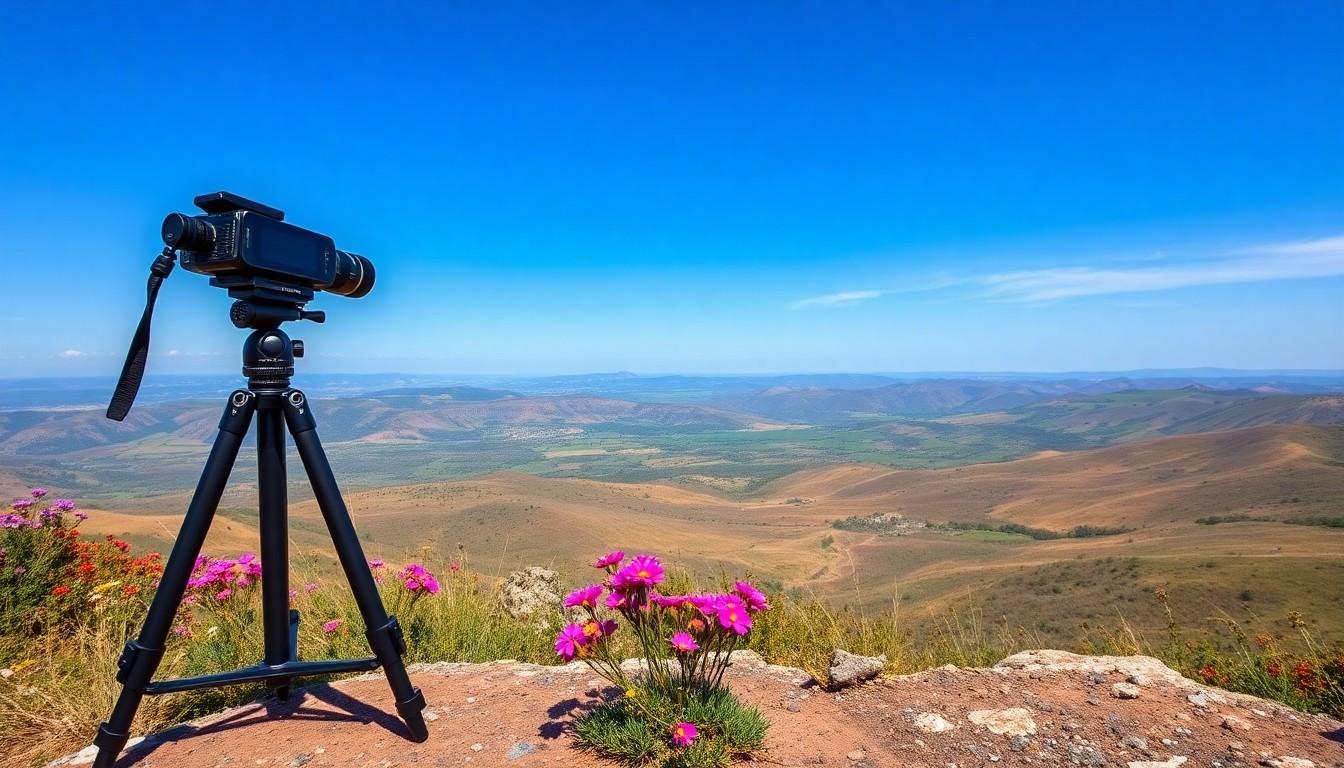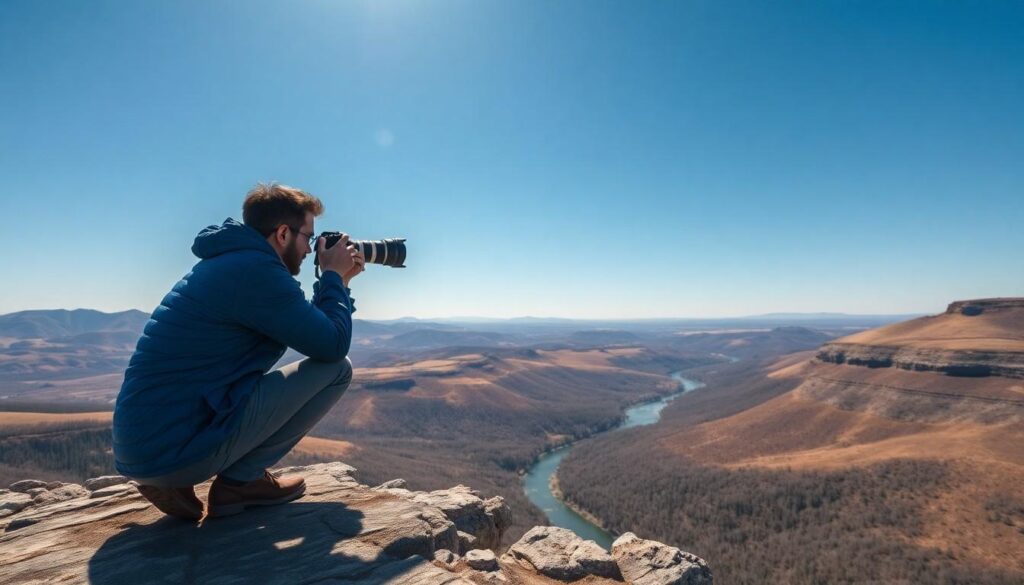Long shot photography is like the superhero of the photography world—capturing sweeping vistas and bustling crowds with ease. It’s the art of telling a story from a distance, where every tiny detail contributes to the grand narrative. Imagine standing on a mountaintop, camera in hand, and freezing that breathtaking landscape in time. It’s not just about the view; it’s about the experience.
But don’t be fooled into thinking long shots are just for landscapes. They can transform everyday moments into epic tales. Whether it’s a wedding dance floor packed with joy or a city street alive with movement, long shot photography invites viewers to step back and soak in the scene. So grab your camera and let’s dive into the world of long shots—where every frame is a canvas waiting to be painted with life and laughter.
Table of Contents
ToggleOverview of Long Shot Photography
Long shot photography captures expansive scenes, showcasing a wide perspective. This style emphasizes context, balance, and the relationship between subjects and their environments.
Definition and Importance
Long shot photography refers to images that depict a wide view, allowing subjects to coexist within their surroundings. This style conveys emotion and narrative by integrating the larger scene. Such shots create a sense of space and scale, often highlighting environmental elements alongside the main subjects. The importance of long shots lies in their ability to tell stories visually. They establish context and invite viewers to explore the intricacies of a scene or moment.
Common Applications
Long shot photography finds its place in various settings, enriching visual storytelling. Nature photography benefits greatly, capturing expansive landscapes or vast skies. In portrait photography, it showcases subjects in relation to their environments, emphasizing their actions and interactions. Events like weddings and concerts also utilize long shots to document the atmosphere and energy of the occasion. Urban photography thrives on this technique, highlighting cityscapes and capturing bustling streets filled with activity.
Techniques for Capturing Long Shots

Capturing long shots requires understanding specific techniques that enhance the overall outcome. Proper camera settings and composition create impactful images.
Camera Settings and Equipment
Use a wide-angle lens for expansive landscapes and environments. Set the aperture between f/8 and f/11 for optimal sharpness. Maintain a lower ISO between 100 and 400 to minimize noise and preserve detail. Choose a shutter speed of 1/250 seconds or faster to freeze movement effectively. Consider utilizing a tripod to ensure stability, especially in low light conditions. Adjust camera settings according to lighting conditions for the best results.
Composition Tips
Incorporate foreground elements to add depth to the scene. Frame subjects strategically to enhance storytelling. Utilize the rule of thirds to create balance within the composition. Employ leading lines to guide the viewer’s eye through the photograph. Highlight negative space for emphasis on subjects. Recognize patterns and textures in the environment to create visual interest. Capture moments with movement, such as flowing water or rustling leaves, to infuse dynamism into the shot.
Benefits of Long Shot Photography
Long shot photography offers several advantages that elevate both the aesthetic and emotional impact of images.
Enhancing Storytelling
Long shots help encapsulate narrative elements effectively. They position subjects within their environments, drawing connections that speak volumes. Capturing the scale of a scene allows viewers to appreciate the context behind the action. For example, a couple dancing at a wedding appears more connected to their surroundings, creating a rich storytelling layer. This technique invites viewers to engage with the story unfolding within the frame. Photographers can convey atmosphere by including atmospheric elements, like weather or architectural features, thereby enriching the narrative thread.
Creating Visual Impact
Visual impact is another key benefit of long shot photography. This style highlights expansive landscapes, making them appear majestic and immersive. By showcasing wide perspectives, photographers evoke feelings of awe and wonder in viewers. Consider a sweeping mountain range; it can inspire admiration and curiosity. Well-composed long shots direct the eye, guiding attention to focal points while maintaining the grandeur of the setting. Integrating diverse elements, such as wildlife or human figures, enhances engagement and creates multiple focal points. In essence, the ability to illustrate vastness and detail simultaneously captivates audiences, making long shots a powerful tool in visual storytelling.
Challenges in Long Shot Photography
Long shot photography presents unique challenges that photographers must navigate. Understanding these difficulties can lead to more effective techniques.
Depth of Field Considerations
Depth of field plays a crucial role in long shot photography. Achieving the desired focus can be challenging when capturing vast landscapes. Photographers often use smaller apertures, such as f/8 to f/11, to maintain sharpness from foreground to background. This approach can, however, result in slower shutter speeds. Using a tripod helps mitigate camera shake in such situations. Careful planning of distances between subjects ensures clear focus across the entire frame. Adjusting focus points effectively enhances the visual impact, drawing attention to important elements in the scene.
Environmental Factors
Environmental factors significantly influence long shot photography outcomes. Weather conditions, such as fog or rain, can affect visibility and contrast in the image. Photographers often adjust settings to counteract these effects, using higher ISO values while managing noise levels. Natural light varies throughout the day, making golden hour ideal for capturing depth and mood. Awareness of changing light conditions assists in making timely adjustments. Additionally, moving subjects within the frame, like animals or people, can introduce challenges, requiring quick reflexes to maintain sharp focus. Such dynamic factors enhance the complexity of long shot photography and inspire creative adjustments.
Long shot photography opens up a world of creative possibilities. By capturing expansive scenes and the intricate relationships between subjects and their environments, photographers can tell powerful stories that resonate with viewers. This technique not only enhances visual narratives but also evokes emotions that draw people into the moment.
As photographers experiment with different settings and compositions, they’ll discover the unique challenges and rewards that long shots present. Mastering this art form invites a deeper appreciation for the beauty of everyday life and the vastness of nature, encouraging a more profound connection with the world around them. Embracing long shot photography is a journey worth taking, one that enriches both the photographer’s experience and the viewer’s engagement.



